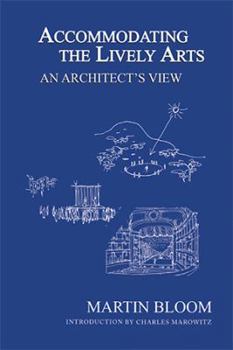Accommodating the Lively Arts: An Architect's View
Select Format
Select Condition 
Book Overview
ACCOMMODATING THE LIVELY ARTS, An Architect's View, insightfully analyzes the needs of those who design theatres, work in theatre, or attend theatre. Illustrating his points with many sketches, Bloom... This description may be from another edition of this product.
Format:Paperback
Language:English
ISBN:1984568396
ISBN13:9781984568397
Release Date:December 2018
Publisher:Xlibris Us
Length:130 Pages
Weight:0.44 lbs.
Dimensions:0.3" x 6.0" x 9.0"
Customer Reviews
3 ratings
A sound, "reader friendly", technical reference guide.
Published by Thriftbooks.com User , 24 years ago
Martin Bloom's Accommodating The Lively Arts provides a technical guide to the design and renovation of theater spaces, from location and shape through fundamentals of theater design. Any involved in theater will find this an important consideration on organizing and building spaces.
This is a little sweetheart of a book.
Published by Thriftbooks.com User , 25 years ago
By no means a glossy record of dramatically realized theater designs, it is rather a gentle manifesto of theater design principles. The author, a practicing designer of theaters, cultural centers, and exhibition structures, says that spaces for live performances should consider three fundamental elements: focus, platform and frame. It all makes perfect sense. The author has added some helpful little sketches, and there is an introduction by Chris Marowitz.
Essentials & insights about theater as experience in space
Published by Thriftbooks.com User , 26 years ago
I picked up this book expecting to read a fairly technical account of how to design and build "better" theaters because I happened to know that it is by an architect who has spent much of his professional life designing theaters and performance spaces. What I discovered is not a "how to" book (although all architects might well profit from its many insights into how architecture should "accommodate" the intended functions and users of a structure.) No, this turns out to be a book by an individual who has spent much of his life involved with theatrical productions on various levels and is here passing on his compressed wisdom about the very essence of what makes for a satisfying and significant visit to the theater. It is not a history of theaters as structures, although it does weave its insights around the historical development of performance spaces, from the earliest Greek threshing floors to contemporary theaters-in-the-round (and there are drawings to help us see the essential elements). It is not particularly concerned with individual buildings by architects, whether well-known or otherwise. It is, rather, about how the elements of physical spaces affect our experience of theatrical productions--serious drama, light comedy, musicals, whatever. On one level, we are all aware of this--whether the seats are too cramped, how the sight lines are obstructed, yes, and whether the ladies room is inadequate. But Martin Bloom has thought much longer and harder and deeper about al these matters, and you end up feeling he has revealed something essential about the point where architecture, theaters, drama, and life intersect.





